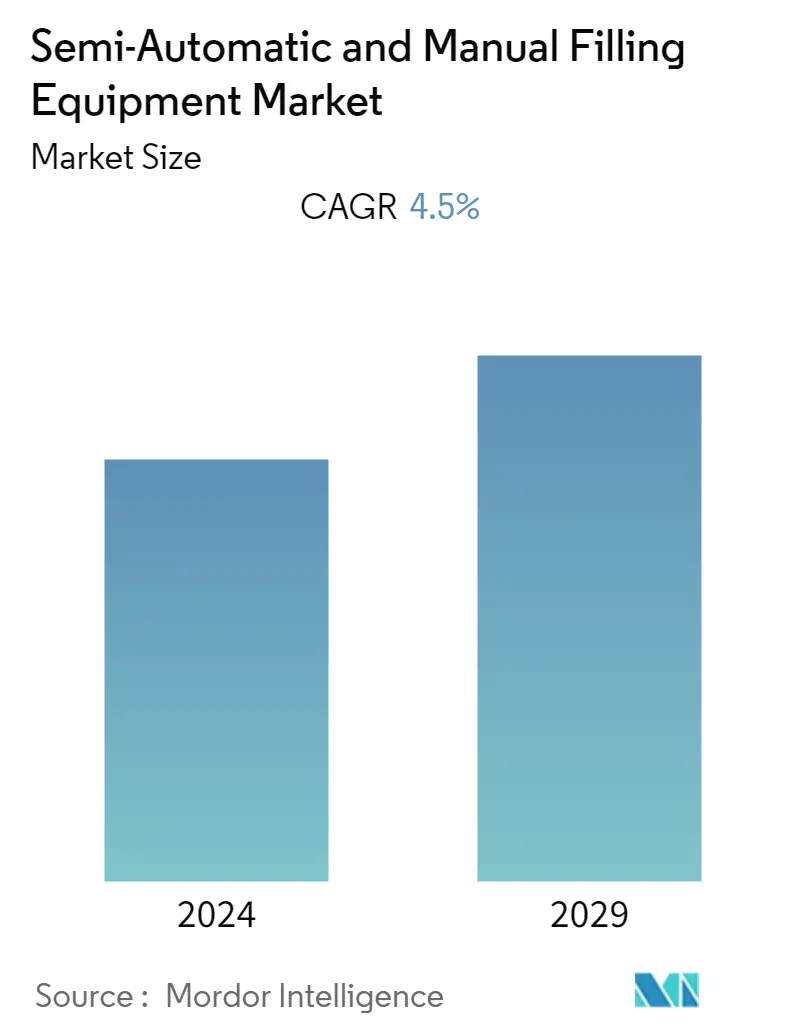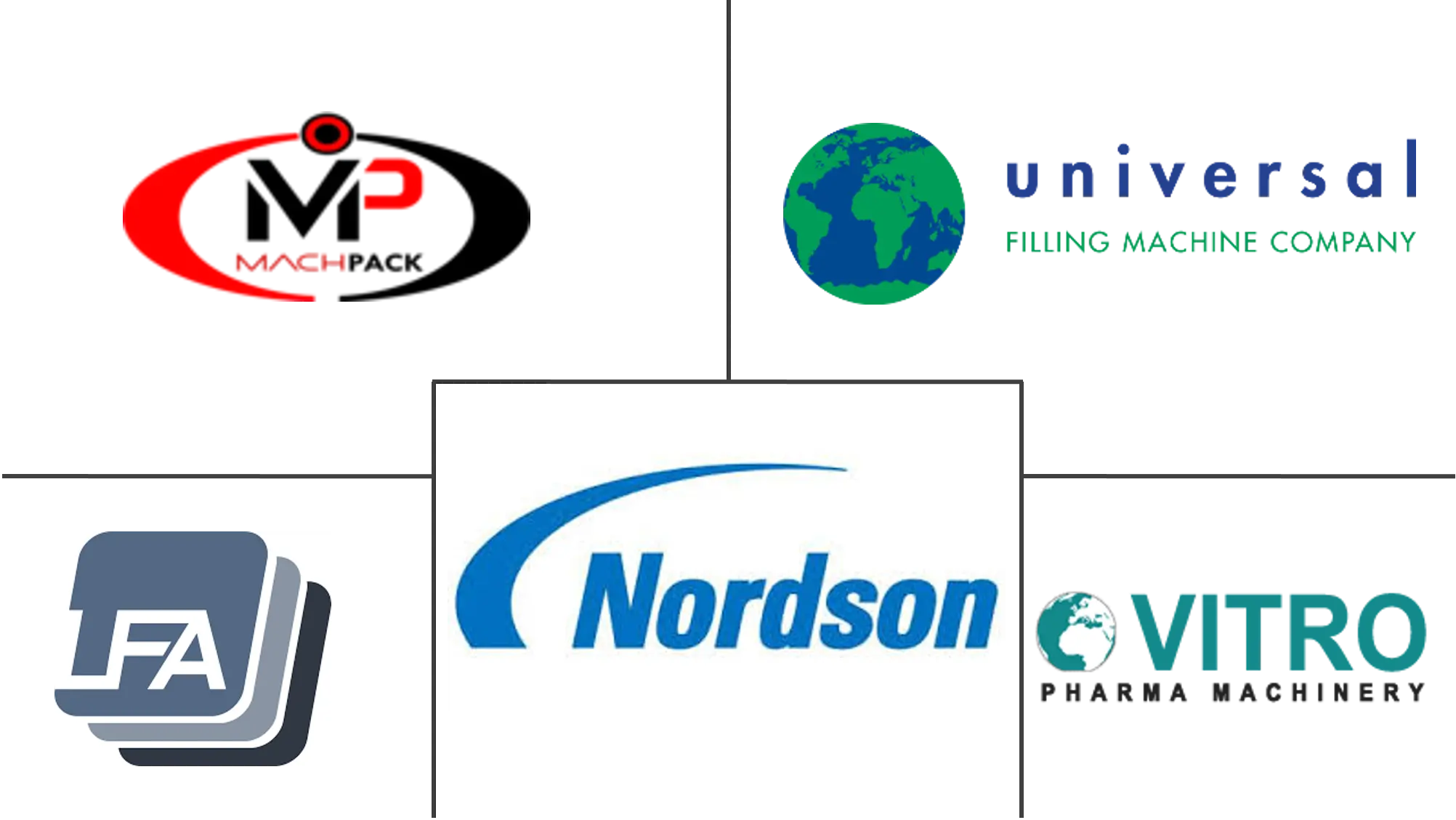Market Size of Semi-Automatic and Manual Filling Equipment Industry

| Study Period | 2019 - 2029 |
| Base Year For Estimation | 2023 |
| CAGR | 4.50 % |
| Fastest Growing Market | Asia Pacific |
| Largest Market | North America |
| Market Concentration | Low |
Major Players
*Disclaimer: Major Players sorted in no particular order |
Semi-Automatic and Manual Filling Equipment Market Analysis
The semi-automatic and manual filling equipment market is expected to grow at a CAGR of 4.5% over the forecast period (2021-2026). With the increase in the requirement for optimizing the assembly line process and to increase efficiency, the trend towards automatic filling machine is helping in lowering the assembly line process, by minimizing human errors, as the process is being operated with the help of computers. In the automatic machines, the inline fillers which are equipped with a sensor count the bottles or containers and are fully equipped with more powerful and modern PLCs. These machines provide the capability to control the packing line, display the tank levels, operate product valves and pumps, have mechanized adjustments and even offer maintenance and troubleshooting checklists.
- The growing demand for filling equipment in the liquid food sector drives the market. According to the FAO( Food & Agriculture Organization of the United Nations), the dairy product demand in the developed and developing countries has been increasing for the past few years particularly in the North American region and the growing demand for fruit juice worldwide rose to 35 billion liters in 2017 which has also been crucial to the market growth.
- Also according to Canadean limited, in 2018 North America showed the highest consumption per capita per liter of fruit juice which is 22.7 and Western Europe with 18.9. This drives the growth of these liquid packaging by which the demand for mostly semi-automatic filling equipment increases in these regions.
- The growing demand to treat chronic diseases that requires continuous vaccination drives the market. Chronic diseases are the primary causes of death and disability globally. Disease rates from these conditions are accelerating globally, advancing across every region and pervading all socioeconomic classes. According to WHO, the estimated cases for chronic disease may reach around 60% globally. As the vaccines for such cases are available in pre-filled syringes form, its increased consumption is expected to boost the market growth.
- High maintenance costs for filling equipment restraints the growth of the market. These machines have a high failure rate and high corrective maintenance cost which deliberately slows down the production rate.
Semi-Automatic and Manual Filling Equipment Industry Segmentation
The Semi-Automatic and Manual Filling Equipment provide filling packaging process of solid, semi-solid and liquid products in various container types, vacuum bags, etc, for end users such as in foods, beverages, pharma, cosmetics, etc.
| By Material Type | |
| Solid | |
| Semi-Solid | |
| Liquid |
| End-User | |
| Food | |
| Beverage | |
| Pharmaceutical | |
| Cosmetics & Household | |
| Other End-Users |
| Geography | |
| North America | |
| Europe | |
| Asia-Pacific | |
| Latin America | |
| Middle-East & Africa |
Semi-Automatic and Manual Filling Equipment Market Size Summary
The semi-automatic and manual filling equipment market is experiencing growth driven by the increasing demand for efficient assembly line processes and the optimization of production efficiency. The trend towards automatic filling machines, which minimize human errors through computer-assisted operations, is contributing to this growth. These machines are equipped with advanced features such as sensors, powerful PLCs, and mechanized adjustments, enhancing their capability to control packing lines and perform maintenance tasks. The demand for filling equipment is particularly strong in the liquid food sector, driven by rising consumption of dairy products and fruit juices, especially in North America and Western Europe. Additionally, the need for continuous vaccination to combat chronic diseases is boosting the market, as pre-filled syringes become more prevalent.
The pharmaceutical industry is a significant contributor to the market's expansion, with the increasing demand for generic medicines and biologics driving the need for filling equipment. The market is characterized by a wide range of machinery, including liquid, powder, and tube filling machines, with semi-automatic equipment being widely used for large-scale filling and ensuring sterility. The Asia-Pacific region, with its high demand for skincare and luxury products, is also a key market, supported by rising disposable incomes and a growing consumer base interested in personal hygiene. The region's demand for filling equipment is further fueled by the rise in chronic diseases and the expansion of pharmaceutical packaging facilities. The market is fragmented, with numerous players globally, and recent developments include new product introductions and capacity expansions by key companies.
Semi-Automatic and Manual Filling Equipment Market Size - Table of Contents
-
1. MARKET DYNAMICS
-
1.1 Market Overview
-
1.2 Market Drivers
-
1.2.1 Growing Demand of Filling Equipment in the Liquid Food Sector
-
1.2.2 Growing Demand to Treat Chronic Disease that Require Continuous Vaccination
-
-
1.3 Market Restraints
-
1.3.1 High Maintenance Cost
-
-
1.4 Industry Value Chain Analysis
-
1.5 Industry Attractiveness - Porter's Five Force Analysis
-
1.5.1 Threat of New Entrants
-
1.5.2 Bargaining Power of Buyers/Consumers
-
1.5.3 Bargaining Power of Suppliers
-
1.5.4 Threat of Substitute Products
-
1.5.5 Intensity of Competitive Rivalry
-
-
-
2. MARKET SEGMENTATION
-
2.1 By Material Type
-
2.1.1 Solid
-
2.1.2 Semi-Solid
-
2.1.3 Liquid
-
-
2.2 End-User
-
2.2.1 Food
-
2.2.2 Beverage
-
2.2.3 Pharmaceutical
-
2.2.4 Cosmetics & Household
-
2.2.5 Other End-Users
-
-
2.3 Geography
-
2.3.1 North America
-
2.3.2 Europe
-
2.3.3 Asia-Pacific
-
2.3.4 Latin America
-
2.3.5 Middle-East & Africa
-
-
Semi-Automatic and Manual Filling Equipment Market Size FAQs
What is the current Semi-Automatic and Manual Filling Equipment Market size?
The Semi-Automatic and Manual Filling Equipment Market is projected to register a CAGR of 4.5% during the forecast period (2024-2029)
Who are the key players in Semi-Automatic and Manual Filling Equipment Market?
Nordson Corporation, LFA Machines Oxford Ltd., MachPack Process Machines, Universal Filling Machine Co. and Vitro Pharma Machinery are the major companies operating in the Semi-Automatic and Manual Filling Equipment Market.

